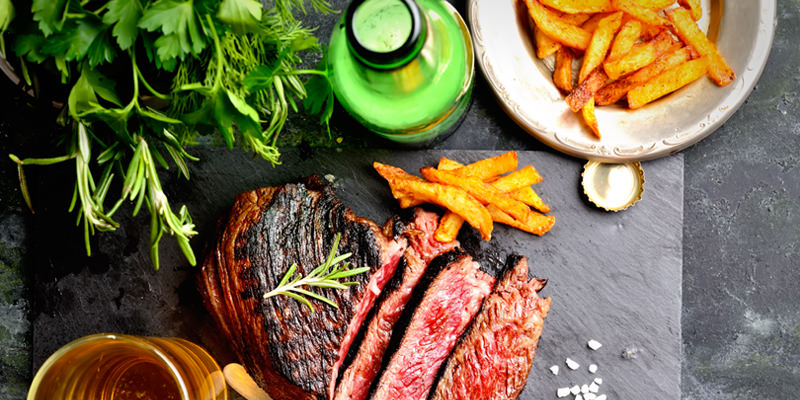
Since I started writing about beer, I’ve had a motto: “There is good living where there is good beer.” Add food to the equation and you go from good living to great living.
Beer is a great match for food because of the complexity of its flavors. Now more than ever before, there’s synergy between the beer and food worlds. With the number of breweries in the U.S. just crossing the 5,000 mark, brewers are producing a range of delicious beers to suit nearly every kind of food. And to some in the craft beer world, it’s high time restaurateurs recognized the versatility of craft beer in food pairing.
“Dear Restaurateurs: It’s time to have your menu present beer in the same manner as food and wine,” Julia Herz, the craft beer program director at the Brewers Association and a certified Cicerone, likes to say. Herz wrote the book on beer pairing, literally. She co-authored “Beer Pairing: The Essential Guide from the Pairing Pros.” From classics like barbecue ribs with American brown ale to unusual matches like pineapple upside-down cake with imperial India pale ale, Herz’s book is a deep dive into the science behind every aspect of brewing and the way humans react to flavor.
And it looks like the U.S. is starting to take her advice. As of March 2016, nearly half of craft drinkers say they drink craft with food more frequently now than they did a couple of years ago. It makes sense. Annual beer sales amount to $101.5 billion, $19.6 billion from small and independent U.S. craft brewers. The sales of wine ($37.5 billion) and spirits ($69 billion estimated) combined just barely surpasses the sale of beer. There is unmistakable potential there.
In pairing food with beer, there are some basic, yet important concepts. For starters, match strength with strength. Strongly flavored foods demand assertive beers. I have found that pairing grains like wild rice or polenta with clean and crisp Bohemian-style pilsners or American amber lagers works wonders. The complementary grain flavors balance hops while staying light on the palate. Alternatively, if you love sour and funky beers, try them with rich meats and root vegetables, such as grilled ribeye or lamb. Combining these flavors brings out the umami flavor in both. Even some dishes that are religiously consumed with wine, like filet mignon with Pinot Noir or Cabernet Sauvignon, can benefit from a beer pairing. Stouts and brown ales are bold enough to complement roasted meat, bringing out flavors that wine would not.
Breaking those rules is totally O.K., sometimes even encouraged, says Bill Sysak, or ‘Dr. Bill’ to the craft beer community. Dr. Bill is co-founder and CEO at Wild Barrel Brewing Company and former craft beer ambassador at Stone Brewing. He is respected around the world for his encyclopedic knowledge of beer styles, flavor profiles, and his expertise at pairing beer with food. Dr. Bill believes strongly in being creative with pairings. This is craft beer after all, an industry made up of rule breakers. “It’s not really about contrasting and not contrasting,” he says. “Because all pairings really have complementary and contrasting flavors. I think it’s really letting people’s palates be the guide.”
Wes Lieberher, the executive chef at Beer Belly in Los Angeles’s Koreatown neighborhood, is another rule breaker. If you think a beer bar can’t push the limits, you haven’t tried Wes’s beer- braised octopus. When Lieberher is writing new menus, it’s the idea that comes first, with the consumers’ palates in mind. But when it comes to pairing, he tends to experiment, depending on what’s available. When it comes to pairing with lighter dishes, like his beer-battered fish and chips, Lieberher says he’ll pair the dish with a hoppier IPA, rather than the lighter pilsner that’s used in the dish.
More and more, brewers, restaurateurs, and chefs are using what’s available to them locally, pairing local ingredients with local beers. “I love pairing Northern California creameries, for example, with Northern California breweries,” says Sysak. “It’s just natural.” It also makes it very simple for the consumer to find both of those companies locally in their areas.
“I think the whole localization movement isn’t just isolated to food,” Herz agrees. “That’s where we became aware of it: slow food movement, farm to table, and now it’s farm to keg to tap! And we’ve got brewers thinking like chefs.”
In looking for good beer and food pairings, Herz recommends experimenting and embracing your inner anarchist. In other words, trust your own palate. “We all aren’t the same tasting type,” she says. “And we’re not all going to perceive what we taste as the same. So, it’s all about the journey, experimenting and being able to articulate to yourself or to others what you did and didn’t like.”

